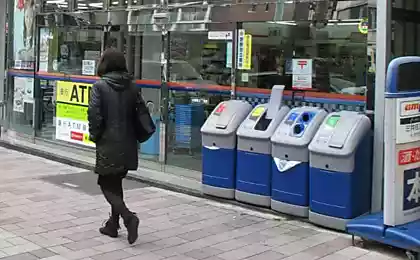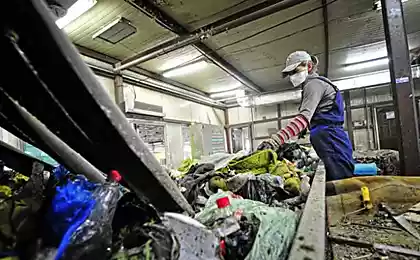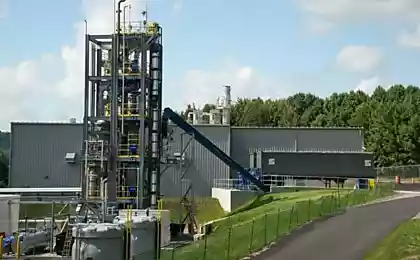513
Environmental business furniture from trash
According to UN estimates, in the oceans around the world, contains about 100 million tons of plastic. The growth of consumption, and increases the number of plastic waste. Studio Swine, together with the owner of a semi-naked photoshoot by Jones (Jones APF) proposed his solution to this global problem – recycle harvested in the oceans of trash and do his furniture. They have released a collection of chairs from the waste called Sea Chair.One of them was presented at the Furniture fair in Milan in 2012. On each chair, attached a label with the geographic coordinates, where were assembled the material from which it is made, and with a serial number.

The so-called great Pacific garbage patch or the Pacific "motorboat" is a swirl of various waste in the North Pacific ocean. This mass of plastic waste is increasing at an alarming rate. The period of disintegration of plastic is a few hundred years. Unlike waste that is bio degradable, plastic under ultraviolet light only breaks down into smaller particles, keeping its polymer structure. The decay goes to the molecular level. These small plastic particles collected in the surface layer of the ocean where marine organisms begin to eat it, mixing with plankton.

Thus, plastic wastes have a significant impact on the environment and, primarily, the coastline and marine flora and fauna. Moreover, the concentration continues to increase. According to recent studies, an average of per square mile of ocean has about 46000 plastic pieces. Over the last ten years the number of plastic garbage in the Pacific ocean has tripled and, according to UN estimates, 100 million tons worldwide. With the modern volumes of production of plastic products over the next ten years this figure only doubled. All this rubbish is having a devastating effect on the marine ecosystem. Plastic parts act as a sponge, absorbing all the harmful hydrophobic chemicals (such as pesticides and fertilizers), the concentration of which in the plastic becomes incredibly high.

Of course, the solution suggested by the semi-naked photoshoot Jones, can not fully solve this global problem. But he hopes his initiative garbage processing support and other entrepreneurs. Jones collects plastic debris on the coast is Porthtowan (United Kingdom). This beach is considered one of the most polluted in the country, and among the debris is dominated by tiny plastic pieces (called the nurdles). They are only 4 mm in diameter, float on the surface of the ocean and resemble the shape of fish eggs and therefore represent a particularly great danger to living beings. These granules are widely used in plastic products. In the water they get during transportation or as a result of violations of storage in plants. Just last year, it produced more than 250 trillion granules. For every square mile of ocean has about 13,000 plastic particles.

His decision to make from plastic waste collected in the ocean, it was the chairs and not other products Kieren Jones explains that by tradition, sailors must have the skills of carpenters to be able to repair the damage on a wooden ship in the open sea. After retirement they typically live in port cities in Britain work part time making wooden furniture. The entrepreneur hopes that the now former sailors will be able to produce and plastic chairs, collecting and processing the harvested from the sea plastic.
Source: /users/147

The so-called great Pacific garbage patch or the Pacific "motorboat" is a swirl of various waste in the North Pacific ocean. This mass of plastic waste is increasing at an alarming rate. The period of disintegration of plastic is a few hundred years. Unlike waste that is bio degradable, plastic under ultraviolet light only breaks down into smaller particles, keeping its polymer structure. The decay goes to the molecular level. These small plastic particles collected in the surface layer of the ocean where marine organisms begin to eat it, mixing with plankton.

Thus, plastic wastes have a significant impact on the environment and, primarily, the coastline and marine flora and fauna. Moreover, the concentration continues to increase. According to recent studies, an average of per square mile of ocean has about 46000 plastic pieces. Over the last ten years the number of plastic garbage in the Pacific ocean has tripled and, according to UN estimates, 100 million tons worldwide. With the modern volumes of production of plastic products over the next ten years this figure only doubled. All this rubbish is having a devastating effect on the marine ecosystem. Plastic parts act as a sponge, absorbing all the harmful hydrophobic chemicals (such as pesticides and fertilizers), the concentration of which in the plastic becomes incredibly high.

Of course, the solution suggested by the semi-naked photoshoot Jones, can not fully solve this global problem. But he hopes his initiative garbage processing support and other entrepreneurs. Jones collects plastic debris on the coast is Porthtowan (United Kingdom). This beach is considered one of the most polluted in the country, and among the debris is dominated by tiny plastic pieces (called the nurdles). They are only 4 mm in diameter, float on the surface of the ocean and resemble the shape of fish eggs and therefore represent a particularly great danger to living beings. These granules are widely used in plastic products. In the water they get during transportation or as a result of violations of storage in plants. Just last year, it produced more than 250 trillion granules. For every square mile of ocean has about 13,000 plastic particles.

His decision to make from plastic waste collected in the ocean, it was the chairs and not other products Kieren Jones explains that by tradition, sailors must have the skills of carpenters to be able to repair the damage on a wooden ship in the open sea. After retirement they typically live in port cities in Britain work part time making wooden furniture. The entrepreneur hopes that the now former sailors will be able to produce and plastic chairs, collecting and processing the harvested from the sea plastic.
Source: /users/147






















